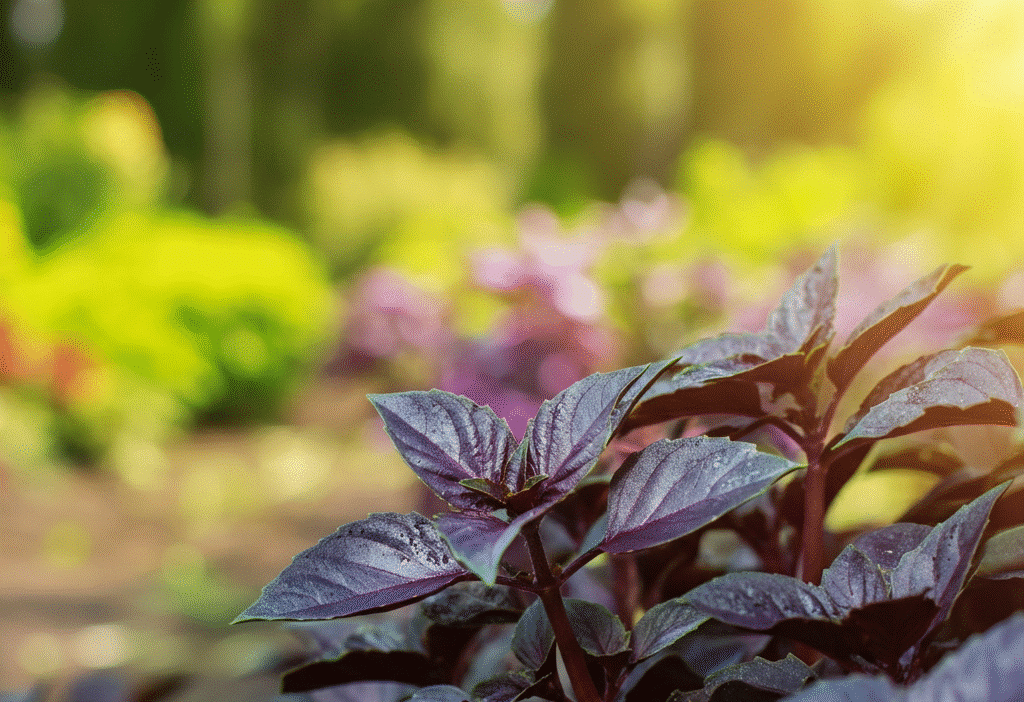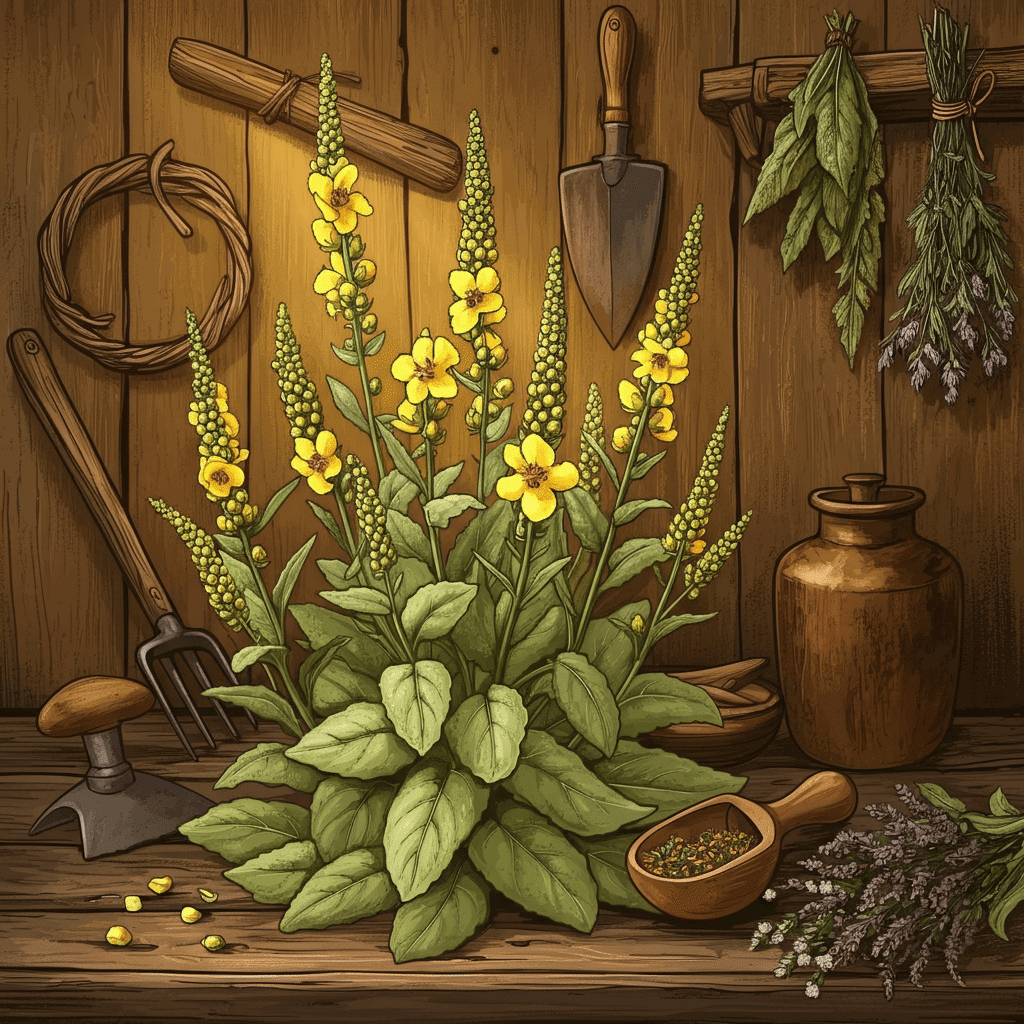Have you ever wondered why some herbs catch your eye more than others? Purple sweet basil does exactly that—its stunning deep purple leaves don’t just add visual appeal to your garden, they pack a powerful punch of flavor and health benefits that can elevate both your cooking and your wellbeing.
This vibrant herb isn’t just another pretty plant for your backyard homestead. Purple sweet basil offers unique nutritional advantages, culinary versatility, and growing opportunities that make it an essential addition to any beginner gardener’s collection. Whether you’re starting your first herb garden or looking to expand your homegrown harvest, understanding the benefits and uses of purple sweet basil will help you make the most of this remarkable plant.
You’ll discover how this colorful variety differs from traditional sweet basil, learn about its impressive health benefits, explore creative ways to use it in your kitchen, and get practical tips for growing your own thriving purple basil plants. By the end of this guide, you’ll have everything you need to successfully grow and enjoy this beautiful, beneficial herb.
Understanding Purple Sweet Basil vs. Regular Sweet Basil
Purple sweet basil and regular sweet basil share the same botanical family, but their differences make each variety special in its own way. Recognizing these distinctions will help you choose the right basil for your specific needs and preferences.
Visual and Flavor Differences
The most striking difference lies in appearance. Purple sweet basil displays rich, deep purple leaves that create stunning contrast in gardens and on plates. Regular sweet basil maintains the classic bright green color most people associate with this popular herb.
Flavor profiles tell another story. Regular sweet basil delivers that familiar sweet, slightly peppery taste that makes it perfect for Italian dishes like pesto and caprese salads. Purple sweet basil offers a similar base flavor but adds subtle notes of clove and a gentle spicy kick. This enhanced complexity makes purple basil incredibly versatile for various cooking styles and cuisines.
The texture remains similar between both varieties, with tender leaves that bruise easily and release their aromatic oils when handled. Both types share that characteristic basil fragrance, though purple basil tends to have a slightly more intense aroma.
Nutritional Powerhouse Differences
While both basil varieties provide excellent nutrition, purple sweet basil has a secret weapon: anthocyanins. These powerful antioxidants give the leaves their distinctive purple color and provide additional health benefits you won’t find in regular sweet basil.
Both varieties remain low in calories while delivering essential nutrients. However, the anthocyanin content in purple basil creates an extra layer of antioxidant protection that can support your overall health in ways regular basil cannot match.
The mineral and vitamin content stays relatively similar between varieties, with both providing vitamin C, vitamin K, and iron. This means you’re getting excellent nutrition regardless of which variety you choose, but purple basil offers that extra antioxidant boost.
Remarkable Health Benefits of Purple Sweet Basil
Purple sweet basil transforms from a simple garden herb into a powerful health ally when you understand its impressive benefits. These advantages make it worth growing even if you’re just starting your homesteading journey.
Antioxidant Protection
The anthocyanins responsible for purple basil’s beautiful color work as potent antioxidants in your body. These compounds actively fight free radicals—unstable molecules that can damage your cells and contribute to aging and chronic diseases.
Research shows that anthocyanins may help reduce the risk of heart disease, certain cancers, and other chronic conditions. When you add purple basil to your meals, you’re not just enhancing flavor—you’re providing your body with protective compounds that support long-term health.
The antioxidant activity in purple basil often exceeds that of many other common herbs. This makes it an excellent choice for anyone looking to boost their antioxidant intake through natural, homegrown sources.
Digestive Health Support
Purple sweet basil contains essential oils, particularly eugenol, that can soothe your digestive system naturally. These compounds help reduce inflammation in your digestive tract and may alleviate common issues like indigestion and bloating.
Traditional medicine has long recognized basil’s digestive benefits, and modern understanding supports these uses. The essential oils can help stimulate healthy digestion and may reduce discomfort after meals.
For homesteaders interested in natural health solutions, having fresh purple basil available means you can address minor digestive issues with herbs from your own garden. This self-sufficiency aligns perfectly with sustainable living goals.
Anti-Inflammatory Properties
The essential oils in purple sweet basil provide natural anti-inflammatory effects throughout your body. Chronic inflammation contributes to many health problems, from arthritis to heart disease, making these anti-inflammatory properties particularly valuable.
Regular consumption of purple basil may help reduce inflammation markers in your body. This doesn’t mean it replaces medical treatment, but it can be part of an overall healthy lifestyle that supports your body’s natural healing processes.
The anti-inflammatory benefits work both when you consume purple basil and when you use it in natural remedies. Some people find that basil-infused oils or teas help with minor inflammatory conditions.
Immune System Boost
Purple sweet basil delivers essential vitamins and minerals that support healthy immune function. Vitamin C, vitamin K, and iron all play crucial roles in maintaining a strong immune system that can help fight off infections and illnesses.
The combination of antioxidants, essential oils, and nutrients creates a synergistic effect that may enhance your body’s natural defense systems. This makes purple basil an excellent addition to your diet, especially during seasons when immune support becomes more important.
Growing your own purple basil ensures you have fresh, potent herbs available whenever you need an immune boost. Fresh herbs typically contain higher levels of beneficial compounds compared to dried alternatives.
Creative Culinary Uses for Purple Sweet Basil
Purple sweet basil opens up exciting culinary possibilities that go far beyond traditional basil applications. Its unique flavor and stunning appearance make it perfect for both everyday cooking and special occasions.
Salads and Fresh Applications
The vibrant purple leaves create stunning visual appeal in fresh salads and raw preparations. Mix purple basil leaves with greens for an instant color boost, or use whole leaves as an edible garnish that adds both beauty and flavor.
Purple basil pairs wonderfully with fresh mozzarella, tomatoes, and other traditional caprese ingredients. The slight spicy kick and clove notes complement these classic flavors while adding visual interest to the dish.
Try tearing purple basil leaves into fruit salads for an unexpected twist. The herb’s complex flavor profile works surprisingly well with stone fruits, berries, and citrus, creating sophisticated flavor combinations that will impress your family and guests.
Pesto and Sauce Innovations
Traditional pesto gets a dramatic makeover when you substitute purple basil for regular basil. The resulting sauce has a beautiful deep color and enhanced flavor complexity that transforms ordinary pasta dishes into gourmet experiences.
Purple basil pesto works excellently as a spread for sandwiches and wraps. The visual appeal makes even simple lunches look restaurant-worthy, while the enhanced flavor keeps things interesting for your taste buds.
Experiment with mixing purple and green basil in your pesto recipes. This combination creates interesting color patterns and flavor layers that add complexity to your homemade sauces.
Infused Oils and Vinegars
Creating infused oils with purple basil produces both beautiful and functional kitchen staples. The purple leaves create stunning visual appeal in clear bottles while infusing the oil with complex flavors perfect for drizzling over salads or bread.
Vinegar infusions capture purple basil’s essence in a shelf-stable form you can use year-round. These infusions make excellent gifts and allow you to preserve your garden’s harvest for months after the growing season ends.
The infusion process itself is simple and rewarding. Place clean purple basil leaves in sterilized bottles, cover with your chosen oil or vinegar, and allow the flavors to develop over several weeks. The results provide gourmet ingredients made from your own backyard harvest.
Beverage Applications
Purple basil creates refreshing and visually stunning beverages that showcase both its flavor and color. Muddle fresh leaves in lemonades, iced teas, or cocktails for an herbal twist that’s both delicious and Instagram-worthy.
Herbal teas made from purple basil leaves offer a caffeine-free way to enjoy the herb’s benefits. The resulting tea has a pleasant flavor and may provide some of the same health benefits as consuming fresh leaves.
Try freezing purple basil leaves in ice cubes for a beautiful and functional addition to summer drinks. As the ice melts, it releases subtle basil flavors while creating an elegant presentation.
Growing Purple Sweet Basil Successfully
Growing purple sweet basil successfully requires understanding its specific needs and preferences. With proper care, you can enjoy abundant harvests of this beautiful and beneficial herb throughout the growing season.
Optimal Planting Conditions
Purple sweet basil thrives in well-draining soil with a pH between 6.0 and 7.0. Test your soil before planting to ensure optimal growing conditions. If your soil is too acidic or alkaline, you can amend it with compost or other organic materials to achieve the right pH balance.
Choose a location that receives at least 6-8 hours of direct sunlight daily. Basil is a heat-loving plant that performs best in warm, sunny conditions. In cooler climates, consider container growing so you can move plants to optimal locations throughout the day.
Plant seeds or seedlings after all danger of frost has passed and soil temperatures reach at least 60°F. In most areas, this means waiting until late spring or early summer for outdoor planting. Starting seeds indoors 4-6 weeks before your last frost date allows for earlier transplanting and longer harvests.
Watering and Fertilizing Techniques
Maintain consistent soil moisture without waterlogging your purple basil plants. Water deeply but infrequently, allowing the top inch of soil to dry between waterings. This encourages deep root development and prevents fungal issues that can plague overwatered basil.
Apply water at the base of plants rather than overhead watering. This keeps leaves dry and reduces the risk of fungal diseases. Drip irrigation or soaker hoses work excellently for basil plantings.
Feed your purple basil with balanced, water-soluble fertilizer every 4-6 weeks during the growing season. Organic options like fish emulsion or compost tea provide excellent nutrition while supporting soil health. Avoid high-nitrogen fertilizers that promote excessive leaf growth at the expense of flavor concentration.
Pruning and Harvesting Strategies
Regular pruning encourages bushy growth and prevents premature flowering. Pinch off flower buds as soon as they appear to maintain leaf production and flavor quality. Once basil flowers, leaf production decreases and flavor becomes less intense.
Harvest leaves from the top of the plant, cutting just above a set of leaves. This technique encourages the plant to branch out and produce more foliage. Never harvest more than one-third of the plant at any one time to ensure continued healthy growth.
Morning harvesting provides the best flavor and essential oil content. Choose leaves that are fully developed but still tender, avoiding older, tougher leaves that may have bitter flavors.
Container Growing Options
Container growing works excellently for purple basil, especially for beginners with limited garden space. Choose containers at least 12 inches wide and deep to provide adequate root space for mature plants.
Use high-quality potting mix designed for herbs and vegetables. Garden soil becomes too heavy and poorly draining in containers, leading to root problems and poor plant performance.
Container-grown basil requires more frequent watering than garden-planted herbs. Check soil moisture daily during hot weather and water when the top inch feels dry. The enhanced drainage in containers means nutrients wash away more quickly, so container plants may need more frequent fertilizing.
Preserving Your Purple Basil Harvest
Maximizing your purple basil harvest means learning effective preservation methods that maintain flavor and nutritional benefits throughout the year. These techniques allow you to enjoy your homegrown herbs long after the growing season ends.
Drying and Storage Methods
Air drying works well for purple basil, though the leaves will lose their vibrant color during the process. Bundle small groups of stems and hang them in a warm, dry, well-ventilated area away from direct sunlight. Properly dried basil should crumble easily and maintain good flavor.
Oven drying offers faster results when you need preserved basil quickly. Set your oven to the lowest temperature (usually around 170°F) and dry leaves on baking sheets for 2-4 hours. Check frequently to prevent over-drying or burning.
Store dried purple basil in airtight containers away from light and heat. Properly stored dried basil maintains good flavor for up to one year, though it’s best used within 6 months for optimal taste.
Freezing Techniques
Freezing preserves more of purple basil’s fresh flavor compared to drying. Blanch leaves quickly in boiling water, then immediately plunge into ice water to stop the cooking process. Pat dry and freeze in single layers before transferring to freezer bags.
Ice cube freezing creates convenient portion-sized servings. Chop fresh purple basil and place in ice cube trays with a small amount of water or olive oil. Once frozen, transfer cubes to freezer bags for easy use in cooking.
Frozen purple basil works best in cooked dishes rather than fresh applications. The texture changes during freezing, but the flavor remains excellent for soups, sauces, and other heated preparations.
Troubleshooting Common Growing Issues
Even experienced gardeners encounter challenges when growing purple basil. Understanding common problems and their solutions helps ensure successful harvests and healthy plants throughout the growing season.
Pest Management
Aphids commonly attack basil plants, clustering on new growth and under leaves. Spray them off with a strong stream of water, or use insecticidal soap for persistent infestations. Encouraging beneficial insects like ladybugs provides natural pest control.
Slugs and snails can damage young basil plants, especially in humid conditions. Use physical barriers like copper tape around containers, or set up beer traps to catch these pests before they damage your plants.
Japanese beetles may feed on basil leaves during their active season. Hand-picking works for small infestations, while row covers provide protection during peak beetle activity periods.
Disease Prevention
Fungal diseases like downy mildew and fusarium wilt can affect basil plants, especially in humid conditions with poor air circulation. Provide adequate spacing between plants and avoid overhead watering to reduce disease pressure.
Root rot develops in waterlogged soil conditions. Ensure proper drainage and avoid overwatering to prevent this serious problem. Container-grown plants are particularly susceptible to root rot if drainage is inadequate.
Bacterial leaf spot appears as dark spots on leaves and stems. Remove affected plant parts immediately and improve air circulation around plants. Avoid working with plants when they’re wet to prevent spreading bacterial diseases.
Companion Planting with Purple Sweet Basil
Purple sweet basil makes an excellent companion plant that can benefit other crops in your garden while creating beautiful, functional plant combinations. Understanding these relationships helps you design more productive and attractive growing spaces.
Beneficial Plant Partnerships
Tomatoes and purple basil make classic garden companions. The basil may help repel certain insects that commonly attack tomatoes, while the tomatoes provide some afternoon shade for the basil in very hot climates.
Peppers grow well near purple basil and may benefit from the herb’s pest-deterrent properties. The similar growing requirements make them easy to manage together, and both crops appreciate warm, sunny conditions.
Lettuce and other cool-season crops can benefit from the light shade purple basil provides as it matures. This relationship works particularly well in areas with hot summers where lettuce might bolt quickly in full sun.
Plants to Avoid
Rue and purple basil don’t grow well together, as rue may inhibit basil’s growth. Keep these plants separated in your garden layout to ensure both perform optimally.
Very aggressive spreading plants like mint can overwhelm purple basil. While both are in the mint family, give basil adequate space away from spreading mint varieties to prevent competition.
Large, shade-casting plants can reduce purple basil’s productivity. Avoid planting basil in the shadow of tall vegetables like corn or large tomato plants that might block essential sunlight.
Maximizing Your Homegrown Success
Growing purple sweet basil successfully becomes easier when you understand the plant’s needs and implement proven techniques. These strategies will help you achieve abundant harvests and thriving plants season after season.
Purple sweet basil offers incredible value for beginner homesteaders and experienced gardeners alike. Its stunning appearance, enhanced nutritional benefits, and versatile culinary applications make it a worthy addition to any herb garden. The health benefits, from antioxidant protection to immune system support, provide additional motivation for growing this remarkable plant.
Start small with just a few plants to gain experience, then expand your purple basil growing as your confidence and skills develop. Remember that successful gardening comes from understanding your plants’ needs and responding to them consistently. With proper care, you’ll enjoy abundant harvests of this beautiful, beneficial herb that can transform both your cooking and your health.
Take action today by planning your purple basil garden space or starting seeds for the upcoming growing season. Join online gardening communities to share experiences and learn from other purple basil growers. Your journey toward greater self-sufficiency and sustainable living begins with simple steps like growing your own nutritious, flavorful herbs.




